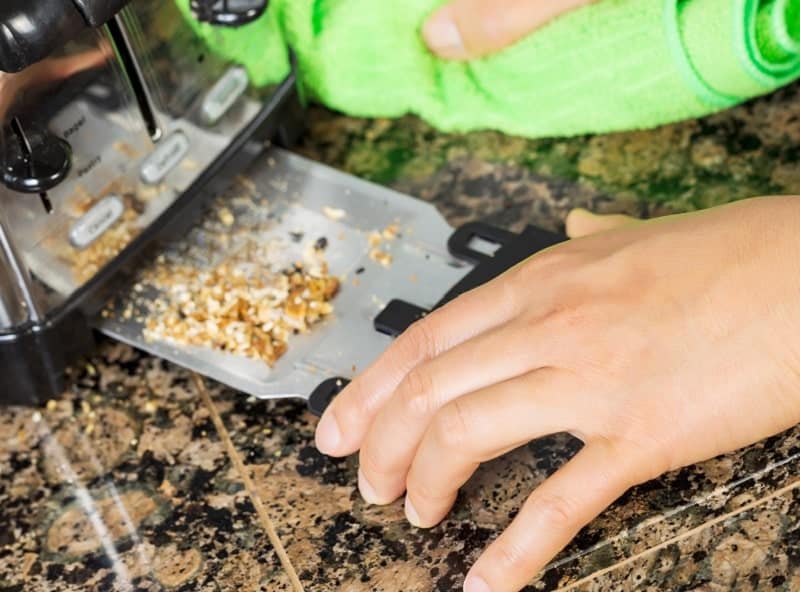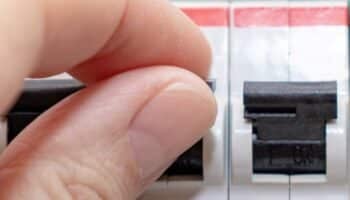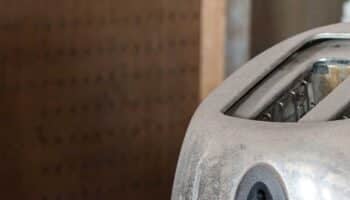The toaster has been around since Alan MacMasters invented it in 1893 in Scotland. The Crompton Company sold Macmaster’s invention, named the “Eclipse Toaster.” Imagine the burning smells that likely overwhelmed people as the iron wiring melted many times over, posing a substantial fire risk for owners of this toaster.
Advances brought the toaster into the 20th century, with solutions that lessened the risk of fires caused by melting iron. The main issue with the first toaster invented and manufactured by an employee of General Electric was the fact that it only toasted one side of the bread. That probably does not sound very appealing to people today that cannot imagine bread toasted only on one side.
Today’s toasters are advanced technology, compared to early toasters, and yet, one common complaint still remains among consumers. The toaster sometimes smells like plastic or like something else is burning inside the toaster. Let’s look at some reasons for this and five tips to fix it so that you can enjoy your toast without worrying about a fire in your home or feeling like you are eating a piece of burnt plastic.
The Plastic Smell
Does your toaster have a plastic smell every time that you use it to make toast? Does that disgusting plastic smell linger in your kitchen or permeate into other rooms of your home? There are several possible reasons for this to occur, and easy ways to get rid of the plastic smell.

The smell of freshly made toast popping up from the toaster in the morning, with melted butter and often covered in jelly or jam, is a pleasant smell for many people. Do you look forward to your morning toast as a regular part of your morning routine, or to relaxing after the kids are gone off to school? You likely do not enjoy it if there is a plastic smell, especially if your toast seems to taste like burnt plastic.
Let’s check out some reasons for a plastic smell coming from your toaster and tips to fix it.
#1 There is actually plastic in the toaster
Did you unwrap a new toaster and quickly remove the packing so that you could use the toaster right away? It is possible that a piece of plastic from the packing materials accidentally dropped inside the toaster when you removed it from the box.
Did you open a new loaf of bread and then tied the bread closed because you could not find the plastic bread tie and have no idea what suddenly happened to it?
How to Fix It
Check the inside of the toaster when you remove it from the box. Make sure that you carefully remove all packing materials so that they do not end up inside the toaster.
Do you have an older toaster that smells like plastic? Open the crumb tray. Check it for plastic. If the crumb tray does not have any plastic, unplug the toaster and check the inside of it for any plastic wrap or pieces of plastic.
#2 You Have a New Toaster
A new toaster seems just as shiny and ready to use as larger appliances. They often have weird smells if you use them right away, including a smell of plastic or a burning smell.
These are common, strange smells that users often report when they purchase a new toaster or another small appliance, such as a toaster oven.
How to Fix It
New toasters smell like burning plastic or like something else that is burning the first time that you use a toaster. This is likely due to the manufacturing process. The plastic smell or burning smell typically disappears after using the toaster a few times.
Do not toast bread immediately after removing the new toaster from the box. Plug in the toaster. Press the lever down as if you had a piece of toast in the toaster. Wait until the lever pops up, and then repeat the process.
Some people actually use two pieces of bread and then throw the first pieces of toast away so that they avoid the plastic or burnt smell and taste. Some other people probably think about the cost of bread and opt for the procedure without bread in the toaster.
#3 The Old Toaster has a Plastic or Burning Smell
Older toasters sometimes release smells that potentially indicate that it does not work properly. Do not assume that the toaster is toast before you check it. There may be a reason for the burnt toast or burned plastic smells, along with an easy way to fix it and prolong the life of your toaster.
How to Fix It
Unplug your toaster and open the crumb tray. Check for something that fell into the tray. Empty the crumbs from the tray. Clean the tray. Next, check inside the toaster. Pieces of bread, muffins, or bagels sometimes break off and become trapped inside the toaster. Check for the thoroughly burned pieces of debris inside the toaster and remove it.

What is the solution if your toaster smells like something is burning and it is an older toaster? Clean the toaster with a gentle cleaning solution. Do not use abrasive cleaners or scrubber sponges on a toaster.
#4 The Plastic Smell Persists in the Toaster
Once a toaster is no longer new, and after you performed the test to remove the plastic smell, your toaster should not smell like plastic or like something burned in the toaster. Are there any strange smells still coming from your toaster, whether it is new or an older toaster?
This is not normal, and needs to be checked for safety issues. People likely think of house fires coming from large appliances, such as when someone leaves food unattended on the stove. The truth is that toasters account for house fires the same as large appliances. It is important to diagnose and fix any plastic smell or burning smell coming from your toaster.
How to Repair It
Check the toaster for dust on the coils. Toasters that sit on a countertop or that are stored inside a cupboard may collect dust on the coils. Use a soft washcloth and gently clean the toaster with warm water and a non-toxic, gentle cleaning solution. Some people use plain water without any cleaners to wipe away dust and debris from their toaster.
Does the burning smell or plastic smell still linger after you clean the toaster? Do not use it until you have someone that knows how to repair toasters to check the toaster. The other solution is to buy a new toaster.
#5 The Bread Bag Did It
Bread bags sitting too close to a toaster are often a cause of the smell of plastic or something burning coming from a toaster. Perhaps you placed the loaf of bread or the package of English muffins or bagels too close to the toaster. Now there is a plastic smell because the toaster has decorations of the melted plastic across the side or top of the toaster.
The unsightly plastic is more than just unattractive. It is a potential risk for fire or a possible health risk. The fumes are a risk for potential respiratory issues. The plastic can cause a flash fire.
How to Remove It
Make sure that you work in a well-ventilated area when removing the plastic from the outside of the toaster. Gently try to remove the plastic as you can remove without using cleaners or tools.
Next, use a non-abrasive cleaner and a soft cloth. Gently rub the area, working in circular motion. The process requires a little patience because it may take a while to remove all the plastic.
Rinse frequently as you remove the plastic. Continue the process until you completely remove the plastic. Let the toaster dry completely before you use it again.
Toasters often emit strange smells, including the smell of plastic or a burning smell. There are several reasons for it, and with a little effort, you can easily follow five tips to diagnose and fix the issue.







